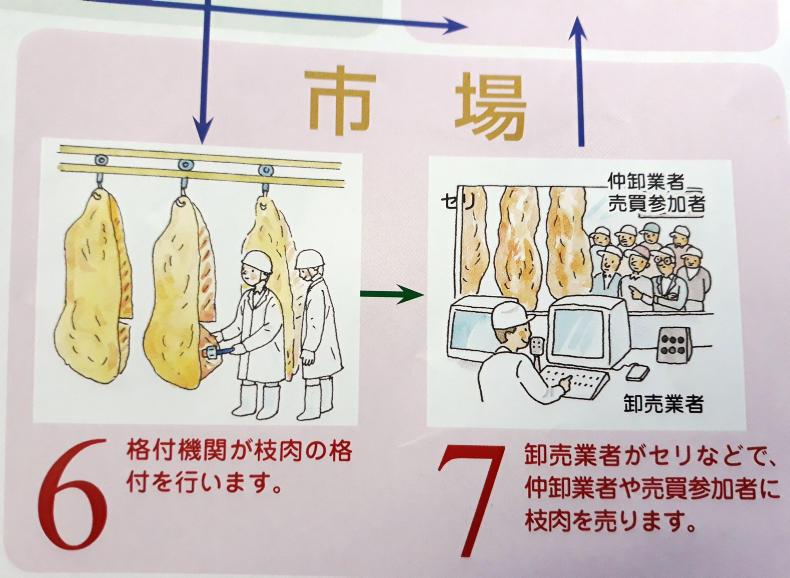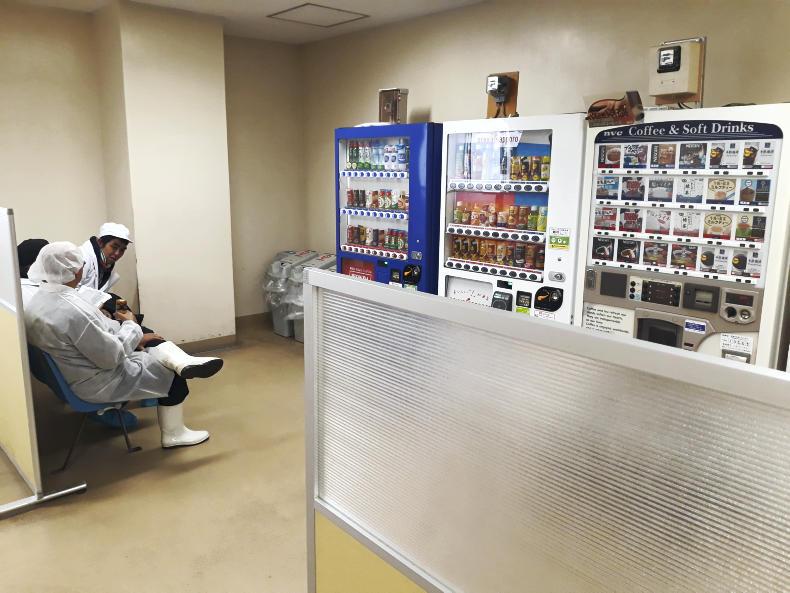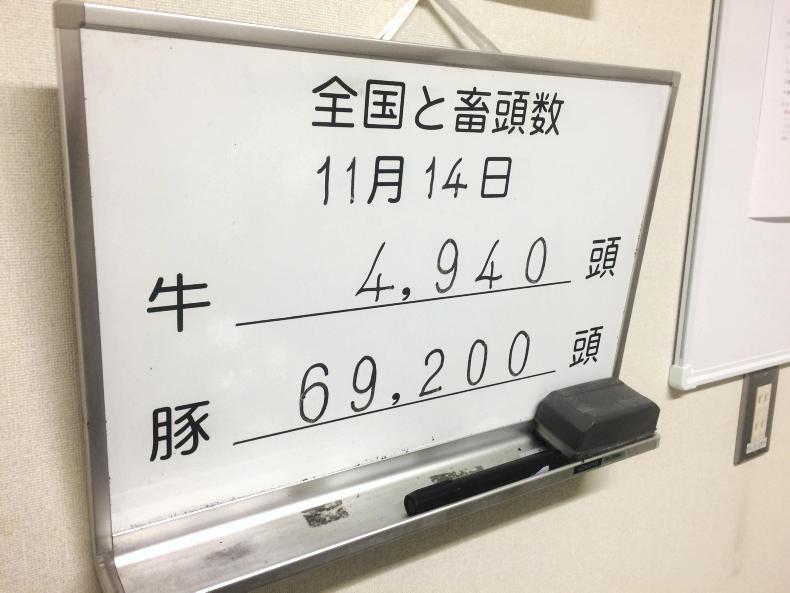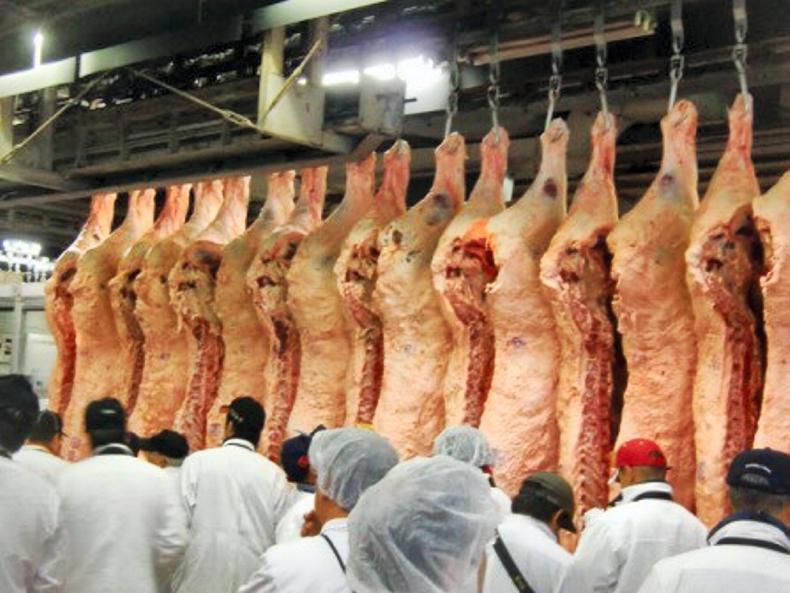The Tokyo Central Meat auction was the quietest mart I have ever been to.
The intense secrecy of the auction, which holds all media in suspicion and forbids the use of photography, is only equalled by the intense silence.
It may seem strange but Japan’s largest meat auction is in the heart of Tokyo city, a stone’s throw from the bustling Shinagawa subway station and ideally located for supermarket and restaurant buyers to come and inspect high-quality carcasses to supply their outlets.

Photography is strictly forbidden inside the meat auction, so here is a Japanese cartoon showing the bidding process.
The plant is publicly owned and accounts for more than 130,000 beef and 210,000 pig carcasses sold every year.
Inspections and grading
Each carcass goes through a series of rigorous inspections by highly regarded and trusted members of the Japan Meat Grading Association.
Carcasses are graded and branded for meat quality and yield. The system uses a 22-point set of criteria, which is based on an A-C grade and meat quality of 1-5.

The Japanese version of an auction catalogue. Numbers with a line through them indicate that an animal is a steer and a black box means the animal is over 30 months of age (not as desirable).
Grade A5 is the very best and highly prized for its weight, rich red colour and dense marbling.
Farmers and suppliers are usually satisfied with the grading and price they receive for carcasses. Many travel up to 1,500km to reach the auction, with all animals slaughtered the day before sale.
Everyone entering the auction must wear white coats, caps and shoe coverings or boots, and walk through a short wind chamber that shoots out chlorine air as you pass and walk through a disinfectant foot bath.
Japan is humid at this time of year but everyone wears thick jumpers under their white coats as the auction room is chilled.
Bidding
Bidding starts at 10am sharp, with buyers yelling “let’s go” in Japanese. Inside the large room, up to 50 buyers in white coats and boots cluster around to inspect a single line of giant carcasses, weighing between 400kg to 600kg, swinging on a continuous conveyor belt in a large factory-style setting.

The Japanese equivalent of a mart canteen.
Buyers move along the line of carcasses, using a torch slung over their shoulders to shine inside carcasses as they move along the conveyor belt.
Once carcasses reach the end of the room, they are stopped briefly and the weight, breed, age and sex of the animal flashes on a large computer screen.
A bell sounds and rapid bidding commences. However, bidding is completely silent as every bidder has a small remote control-sized tool in their pockets.
The remote control has three buttons, one to start bidding, one to put in a bid of 50 Yen and another to put in a bid of 100 Yen.
Each bidder has a unique number, which more seasoned buyers tie across baseball caps, and when bidding completes, their number flashes briefly on the computer screen.
When a carcass is sold, it’s immediately moved along the conveyor belt to a different area of the building.

The number of carcasses on sale that day. The top number is beef, the bottom number is pork.
Bidding is extremely fast-paced, with every carcass sold in less than 30 seconds. Despite the intense silence during bidding, there is an air of camaraderie on the floor as seasoned bidders exchange knowing looks and nods to each other when a friend’s number flashes on the screen.
There are different brands of beef from different areas of Japan, such as Yonezawa and Sendai. Different brands command different prices based on their reputation, and “champion” carcasses can command huge sales.
While I was at the auction, a champion Yonezawa carcass from a Wagyu heifer, grading A5 and weighing 476kg, made 3,210 Yen/kg (€24.07/kg), a price that drew audible gasps from the group of assembled buyers.
Read more
From beef tongues to prime cuts in Japan
Listen: a new trade for Irish cheddar in Japan?
The Tokyo Central Meat auction was the quietest mart I have ever been to.
The intense secrecy of the auction, which holds all media in suspicion and forbids the use of photography, is only equalled by the intense silence.
It may seem strange but Japan’s largest meat auction is in the heart of Tokyo city, a stone’s throw from the bustling Shinagawa subway station and ideally located for supermarket and restaurant buyers to come and inspect high-quality carcasses to supply their outlets.

Photography is strictly forbidden inside the meat auction, so here is a Japanese cartoon showing the bidding process.
The plant is publicly owned and accounts for more than 130,000 beef and 210,000 pig carcasses sold every year.
Inspections and grading
Each carcass goes through a series of rigorous inspections by highly regarded and trusted members of the Japan Meat Grading Association.
Carcasses are graded and branded for meat quality and yield. The system uses a 22-point set of criteria, which is based on an A-C grade and meat quality of 1-5.

The Japanese version of an auction catalogue. Numbers with a line through them indicate that an animal is a steer and a black box means the animal is over 30 months of age (not as desirable).
Grade A5 is the very best and highly prized for its weight, rich red colour and dense marbling.
Farmers and suppliers are usually satisfied with the grading and price they receive for carcasses. Many travel up to 1,500km to reach the auction, with all animals slaughtered the day before sale.
Everyone entering the auction must wear white coats, caps and shoe coverings or boots, and walk through a short wind chamber that shoots out chlorine air as you pass and walk through a disinfectant foot bath.
Japan is humid at this time of year but everyone wears thick jumpers under their white coats as the auction room is chilled.
Bidding
Bidding starts at 10am sharp, with buyers yelling “let’s go” in Japanese. Inside the large room, up to 50 buyers in white coats and boots cluster around to inspect a single line of giant carcasses, weighing between 400kg to 600kg, swinging on a continuous conveyor belt in a large factory-style setting.

The Japanese equivalent of a mart canteen.
Buyers move along the line of carcasses, using a torch slung over their shoulders to shine inside carcasses as they move along the conveyor belt.
Once carcasses reach the end of the room, they are stopped briefly and the weight, breed, age and sex of the animal flashes on a large computer screen.
A bell sounds and rapid bidding commences. However, bidding is completely silent as every bidder has a small remote control-sized tool in their pockets.
The remote control has three buttons, one to start bidding, one to put in a bid of 50 Yen and another to put in a bid of 100 Yen.
Each bidder has a unique number, which more seasoned buyers tie across baseball caps, and when bidding completes, their number flashes briefly on the computer screen.
When a carcass is sold, it’s immediately moved along the conveyor belt to a different area of the building.

The number of carcasses on sale that day. The top number is beef, the bottom number is pork.
Bidding is extremely fast-paced, with every carcass sold in less than 30 seconds. Despite the intense silence during bidding, there is an air of camaraderie on the floor as seasoned bidders exchange knowing looks and nods to each other when a friend’s number flashes on the screen.
There are different brands of beef from different areas of Japan, such as Yonezawa and Sendai. Different brands command different prices based on their reputation, and “champion” carcasses can command huge sales.
While I was at the auction, a champion Yonezawa carcass from a Wagyu heifer, grading A5 and weighing 476kg, made 3,210 Yen/kg (€24.07/kg), a price that drew audible gasps from the group of assembled buyers.
Read more
From beef tongues to prime cuts in Japan
Listen: a new trade for Irish cheddar in Japan?














SHARING OPTIONS